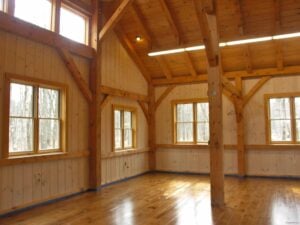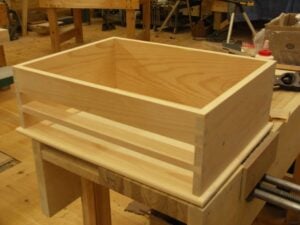More on creative workspace
Today I am stopping in at The Home Depot, my least favourite place to go buy lumber in general, but I am doing it for you, to buy wood for my tool cupboard and storage cabinet. 
Many people feel that squaring stock using hand tools is critically developmental—prior to making and jointing and so on. I wanted something that eliminated machines at the get go and expectations beyond capability too. Squaring stock takes developed and refined skill most people do not have and cannot get straight away. I don’t really care what others say, most new woodworkers cannot accurately square stock straight off the bat and most would-be woodworkers want to make something real first. If they start squaring stock to size without having a working knowledge of the plane and the wood, they will encounter much difficulty. It’s actually easier to simply plane a the surfaces of squared, machine planed or sawn stock first and allow the plane to follow the existing surface that to try to correct out of square, bowed and cupped stock. 
My next book that follows Working Wood is all about dimensioning wood both from the log and squared beams and creating four-square stock to sizes best suited as you make several different types of chests. Remember that everything I do is a course, a new-genre woodworker apprenticing of you will. Here in New York I am working yet again on my creative workspace. 
Our first classes for the US season begin in two-weeks time with two full classes back to back. I am sorry if you wanted to sign in and missed your slot, but please get in touch with the school. We may be able to set other dates depending on the demand.


Hi Paul,
Really looking forward to the next book! I’m working my way through series 1 and 2 of Working Wood now and I’ve been begging for a chapter or two on dimensioning timber as it’s something I’m struggling with. Will the new book be based mainly around using hand-tools as well?
George.
We combine both in the new book, but it’s always going to be primarily focussed on hand tools no matter what. This will expand my course for everyone.
Hi Paul – I’m looking forward to your new book. I’ve been struggling trying to figure out how the old masters cut multiple pieces to the same length. I can’t seem to find anything written anywhere that explains how they did this.
ralph
I cover that in the new book. It’s simple, quick and very effective but not what you expect at all.
I think we all end up with rough sawn eventually but in a blog I just about posted I say use the Home Depot and Lowes for a season until you can shift and find the textures of life you need.
Not at this stage. there are more options now than there were a year ago but I have made good progress on it. We are not sure about the publishers yet and the videoing as yet, but then that’s part of the struggle bringing about a work like this.
Hi Paul
How does the timber section of Home Depot compare to a B&Q at home How do the prices compare I have the feeling that the prices in the US are a lot lower and they have more varieties to chose from, I do know that I can get PAR Red Wood from the local; timber yard for half the price B&Q charge and they will select good defect free lengths for me. Unfortunately they do not stock any hard wood varieties.
I am following your setting up of the New Legacy US with interest it sounds great, you must be excited
Regards
David
I am afraid even though I dislike Home Depot in general, they fair much better than B&Q. THe US prices are still markedly lower than the UK so even oak seems a fair price to me. But you can get a wider variety of everything for the same in dollars so that means it’s around 1/3rd less.I think wherever we can we should go local, even though many local yards don;t deserve good loyalty because of bad staffing issues.
Best regards for now and thanks for writing.
Paul